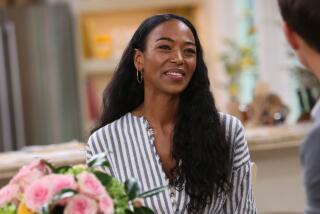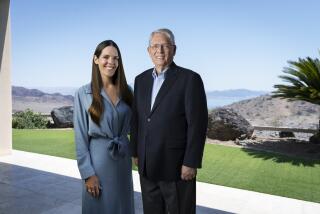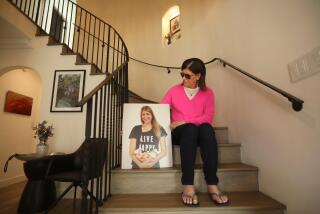Hospital Fights Childhood Cancer With Computer Data Bank
A 4-year-old child shouldn’t have to know what a Broviac catheter is. But Caroline Parkinson does. She has one--and so do most of the other kids she knows.
She also knows that a bone marrow aspiration hurts, but a bone scan doesn’t. She can’t begin to comprehend the principles of physics behind magnetic resonance imaging, but she understands that you have to lie really still or it won’t work.
“Mommy, I’m on a monitor,” she announced the other day, matter-of-factly, sitting in her bed in the oncology ward at Childrens Hospital of Orange County. During the past year and a half, she has spent about six months, off and on, in the hospital.
Her Shirley Temple curls are gone now--they fell out during her first round of chemotherapy. And if it weren’t for the baldness, you’d never guess that she was sick.
Caroline has rhabdomyosarcoma, a form of childhood cancer so rare that it is diagnosed in only one in 2 million children. But to her, the muscle tumor that grew behind her bladder is simply “a bump in my tummy.”
The words “childhood” and “cancer” just don’t seem to belong together.
Childhood is supposed to be carefree and innocent--a few bumps and scratches and sniffles, naturally, but otherwise insulated from the specter of illness and death. And cancer, if it must exist at all, seems more suited to the world of adult worries such as checkbook balances, office politics and internationally instability.
Fortunately, the two don’t often coincide.
When they do, the very rarity of childhood cancer makes treatment and research more difficult, because there aren’t enough young cancer patients at any one hospital to allow doctors to conduct statistically meaningful research, says Dr. Geni A. Bennetts, director of hematology/oncology at CHOC.
And because the various childhood cancers, occurring as they do in rapidly growing and changing bodies, are so different from the more common adult forms, treatment information gleaned from adult studies is only partially useful at best, she says.
So Bennetts, her fellow physicians at CHOC and more than 2,000 of their colleagues at 30 medical institutions nationwide pool their knowledge and resources through the Children’s Cancer Study Group, a networking program administered by the National Cancer Institute.
The program has been in operation for close to 30 years, and in that time, the five-year survival rate for childhood cancers overall has risen from around 10% to more than 70%, nationwide, as well as at CHOC.
Bennetts, who started at CHOC in 1977 as an attending physician and took over the department in 1980, has seen many young patients grow into healthy adults. Since 1980, Bennetts says, more than 300 CHOC cancer patients have participated in the study group.
“Twenty-five or 30 years ago, about all a doctor could do was say, ‘Your child has a couple of months to live,”’ Bennetts says.
That’s pretty much what the doctor who found Caroline’s abdominal tumor told her parents in June, 1988.
Back when the doctor was in medical school, it was considered terminal, says Caroline’s mother, Elizabeth Parkinson. “Take the worst nightmare you could possibly have and multiply it a thousand times--I fainted.”
Caroline was only 3 then, and except for the spotsof blood that suggested something was wrong, she had no symptoms.
The doctor also told Elizabeth Parkinson and her husband, Mark, to take their daughter to CHOC. As they drove toward the hospital fro their Newport Beach home, “it felt like we were driving to a death,” she says.
After two days of tests, the CHOC doctors gave the Parkinsons quite a different prognosis. Caroline’s chances of survival were 60% to 70%, they said. And her best hope, they explained, was to become part of the Children’s Cancer Study Group. The Parkinsons agreed, and suddenly their daughter was not only a cancer patient, but a research subject.
“We would have taken her anywhere to get the best possible treatment,” Mark Parkinson says. “But with the Children’s Cancer Study Group, it didn’t matter, because just about every doctor in the country who deals with this kind of tumor was plugged into the program.”
Almost immediately, Caroline was in surgery, where doctors installed her Broviac catheter--a direct link to her bloodstreamso that she could receive chemotherapy and other intravenous drugs without being turned into a pincushion.
The first course of chemotherapy was grueling.
“She was vomiting every 10 minutes, and she had so many sores inside her mouth that she didn’t talk for weeks,” her mother says. “It’s so hard to take a child who looks so healthy and put them through that.”
But the drugs shrunk the tumor to a small clump of cells, and now, after follow-up chemotherapy and radiation treatments--the entire treatment regimen prescribed by the national program--Caroline’s chances of survival have risen to 85%. She still must come back to the hospital every month for five days of chemotherapy, until her doctors are confident that the tumor is unlikely to grow back.
Even if her cancer never returns, however, Caroline will be affected for the rest of her life.
She will probably never be able to have children, her mother says, because of the effect of the radiation on her ovaries. The radiation also permanently stopped the bone growth in Caroline’s pelvic area. “No matter what, this is something she will always have to live with,” her mother says.
During treatment, the study group’s protocols, or treatment plans, are constantly modified as doctors respond to the latest information.
For example, Elizabeth Parkinson says, when a young girl in Minnesota with the same kind of cancer as Caroline died in a reaction to one of the chemotherapy drugs, doctors nationwide immediately changed the way the drug is administered to make it less dangerous.
Caroline’s cancer was so uncommon that the Children’s Cancer Study Group had only one treatment protocol to recommend. But for most other study group participants, treatment protocols are chosen at random by computer from among options that are considered equally effective.
“I’ve been asked, how can you justify putting a child in a randomized study?” Bennetts says. “But the alternative is for me to go over to the journals on the shelf and pull out a protocol.”
Even with random selection, Bennetts says, “No one gets any less than the best proven results. It’s really not this guinea pig notion; we do the best we know how to do.”
She explained that if the selected protocol does not seem to be effective, based on the national data, all patients in the study are switched to another.
Another advantage, Bennetts says, is that the study group network “gives us access to all the clinicians around the country. If you don’t know, you can find somebody who’s got the experience. They’re all a phone call away from you. You can get all the opinions you want without sending your patients all around the country.
“It makes me feel better, because when I look families in the face, I can tell them, ‘You’ll get the same treatment here as you would get at UCLA or anywhere else in the country, because everyone’s participating. No one needs to feel like there’s a better place.”
If a child isn’t doing well on a prescribed protocol, Bennett says, the program also gives doctors access to drugs that have not yet been licensed by the U.S. Food and Drug Administration.
“Generally, there is some adult data before we begin using these drugs on children,” she says. “As an adult, if I have a tumor that’s resistant to standard treatment, I can decide for myself whether to try an experimental drug. But for a child, the decision is made by a parent.”
When their son, Robbie, then 4, was found to have acute lymphocytic leukemia 3 1/2 years ago, Lee and Janet Clarke of Irvine didn’t want him to be treated with radiation. They feared there would be long-term side effects.
But doctors encouraged the Clarkes to enroll Robbie in the Children’s Cancer Study group.
“They told us that we didn’t have to participate if we didn’t like what came out, or we could drop out anywhere along the way,” Janet Clarke says. “So we decided to go ahead and see what the computer said.”
When the word came back that Robbie had been placed in the non-radiation group, his parents didn’t hesitate to keep him in the program.
“Since then, they’ve changed it so that nobody” with Robbie’s type of leukemia has radiation anymore, Janet Clarke says.
A few parents, Bennetts says, decline to enroll their children in the program.
“That’s fair,” she says. “In those cases, I go back to the data from previous protocols and choose one of the regimens that has done well.”
Robbie, now 7, is scheduled to complete his treatment next spring.
“He doesn’t want to go anymore,” his mother says. Robbie’s least-favorite procedure is what he calls “the poke in the back,” in which anti-cancer drugs are injected into his spinal fluid, the alternative to radiation treatment. Robbie also takes his chemotherapy drugs orally every day, the pills wrapped in pieces of fruit roll to make them easier to take.
“When he was diagnosed, suddenly there was a huge stack of papers we had to go through and decisions that had to be made,” Janet Clarke says. “It was just such a shock. You feel like you’re drowning.”
Telling parents that a child has cancer, Bennetts says, “Is the hardest part. You just absolutely destroy the world as they’ve known it.”
“You feel like you’ve lost control, not only over what happens to your child, but your whole life,” MarkParkinson says. “But you learn to adapt, because you don’t have any choice.”
“At first you think, there’s no way my child can go through this,” Janet Clarke says. “But Robbie has shown us how to handle it.”
“Kids are neat because they’re grateful for each day they feel well,” Bennetts says. “They’re not so worried about whether they’re going to grow up and get married and drive a BMW. Adults tend to be a little more pessimistic.”
For Robbie, the low point was a bout with pneumonia.
Chemotherapy weakens the immune system, leaving cancer patients extraordinarily susceptible to infection. “At one point, a pulmonary specialist came in and asked for permission to use an experimental drug on him because nothing else was working,” Janet Clarke says. “That was too much for me. I just couldn’t accept that we were to that point.”
But after a second look at Robbie’s X-rays, the doctor decided to wait. Luckily, Robbie recovered without the experimental drug.
Robbie’s parents are grateful that he has spent barely more than a week in the hospital since his diagnosis. They have another child, 10-year-old Alison, and Janet Clarke knows that because of Robbie’s illness, they often haven’t been able to give her the attention she needed, even though most of Robbie’s treatment has been on an outpatient basis.
“It’s kind of fun being in the hospital because you don’t have to go a lot of places and you can stay in bed as long as you feel like it,” Robbie says. “But it’s kind of scary too.”
Thirteen-year-old Dana Hashide of Huntington Beach was an only child 8 years ago when she became ill.
“It seemed to come on overnight,” says her father, Mark Hashide. “She was tired and pale, and she fell asleep at her desk at school.”
Dana’s mother, Lynn Hashide, took her to the doctor,” and he told me to come back the next day and bring my husband,” she says. From there, Dana was sent to a Fountain Valley hospital, then transferred by ambulance to CHOC.
“Words like ‘cancer’ and ‘leukemia’ weren’t even in our dictionary then,” Mark Hashide says.
Like Robbie, Dana was found to have acute lymphocytic leukemia. The leukemia, which are diseases of the blood-forming organs, are the most common form of childhood cancer, accounting for about half of all cases.
“It was all just a blur,” Mark Hashide says. “But when they explained the Children’s Cancer Study Group, it seemed to make sense.”






